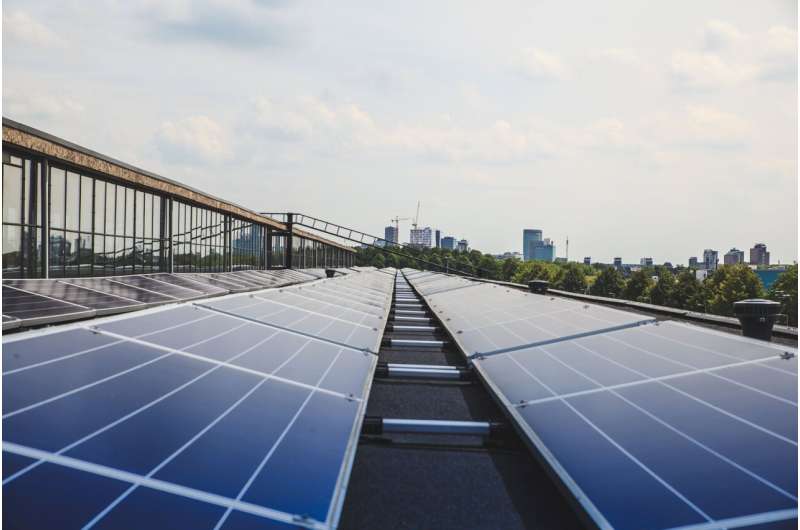This article has been reviewed according to Science X's editorial process and policies. Editors have highlighted the following attributes while ensuring the content's credibility:
fact-checked
trusted source
proofread
Finnish and French cities chart Europe's path to clean energy

As Europe strives to become the first climate-neutral continent by 2050, Turku and Dijon are among a group of cities seeking to reach this goal two decades earlier.
In 2029, Finland's oldest city, Turku, will celebrate reaching the grand old age of 800. At the same time, it hopes to reach another major milestone—becoming climate-neutral. The French city of Dijon 2,000 kilometers away hopes to achieve the same goal by 2030.
The two are part of the Cities Mission—an EU initiative to create 100 climate-neutral cities by the end of this decade. Turku and Dijon are also flagship members of the RESPONSE project to help cities chart the path toward clean energy.
City labs
"We're finding new ways to empower different kinds of citizens," said David Goujon, the project's coordinator.
Three-quarters of EU inhabitants live in urban areas. Worldwide, cities account for more than 65% of global energy consumption and more than 70% of greenhouse-gas emissions—making them key players in the fight against global warming.
A wide range of green technologies has been developed, from solar panels to quadruple glazing, but selecting the best mix to meet each city's particular needs is far from straightforward.
RESPONSE has set out almost 100 options from which cities can select a mix that works best for their specific situations. Examples include biomethane produced from sewage sludge, predictive home thermostats and high-performance ventilation systems.
The project is also running workshops and hackathons to introduce citizens to the available energy-saving tools, encouraging them to use less and lower their bills.
A wide variety of options will be tested in Turku and Dijon, the project's two "lighthouse cities." Six fellow cities—Brussels (Belgium), Zaragoza (Spain), Botoșani (Romania), Ptolemaida (Greece), Gabrovo (Bulgaria) and Severodonetsk (Ukraine)—will look to apply what is learned.
One key goal is to create "positive energy districts" in these cities—meaning they produce more energy than they consume. The ultimate aim is for 20% more energy to be produced than consumed on an annual basis, but to achieve a positive balance at a minimum.
Local differences
The idea was to cover a range of cities with varying characteristics and at different stages on the sustainability path to test what works for different populations, according to Goujon, sustainable city project manager at the European Institute for Energy Research (EIFER) in Karlsruhe, Germany.
The focus in Turku is on its large student population—with the city home to several universities and about 40,000 higher-education students. The focal point in Dijon comprises many lower-income households with a broad cultural mix of nationalities.
"It's two totally different worlds that we're addressing," said Goujon.
RESPONSE hopes that Turku and Dijon can inspire other cities in Europe to follow and scale up their examples.
"We could advise the European Commission that some of these solutions are perfect in the conditions of Dijon, others are very good in the conditions of Turku, and then the fellow cities can learn from this," said Monjur Murshed, co-coordinator of RESPONSE and senior project manager for climate-neutral communities at EIFER.
Over the past six months, RESPONSE has undertaken activities including refurbishing buildings in Dijon and Turku and installing quadruple-glazed windows and solar technologies.
In both cities, the team is testing community-based options for generating renewable energy. In a district of Dijon, for example, 1,100 inhabitants will participate in an initiative to harvest solar energy in the second half of 2023. Smart public lighting and infrastructure for electric vehicles, as well as cloud-based smart energy systems, are other options under consideration in the two cities.
What's working best should become clearer in the coming year. Goujon and Murshed think the project's positive-energy goals are achievable by 2024.
Green purchases
A project called XPRESS has sought to increase city planners' uptake of renewable energy solutions (RES) by bringing together small and medium-sized enterprises (SMEs), public authorities and end users of technology.
The tools developed include a searchable database with RES-related tenders and green public procurement projects across 10 European countries—Belgium, Denmark, Germany, Italy, Norway, Portugal, Slovakia, Spain, Sweden and the U.K.
The database aims to make it easier for SMEs to access RES tenders and, by extension, increase the adoption of innovative solutions by cities—leading to greater energy savings and lower carbon emissions.
XPRESS has tried to spur public authorities to look at the full long-term environmental impact of products across their lifecycle rather than just their initial price.
"The goal is to bring authorities to write public tenders taking into consideration the real impact on the environment in the cost of the purchase," said project coordinator Riccardo Coletta of the Agency for the Promotion of European Research (APRE) in Rome, Italy. "You cannot consider only the price you're going to pay for a service, or for energy or new cars for your public transport fleet."
Coletta highlighted advances in electric transport in the Portuguese city of Braga, which he said has had a strong commitment to pushing green mobility through the development of fully electric buses, promotion of electric vehicles and construction of charging stations.
The Danish island of Samsø, home to 4,000 inhabitants, is another notable case. In 2007, it became the world's first island to be powered entirely by renewable energy. Community involvement has been key to the island's rapid progress.
Larger areas can build on these examples, according to Coletta.
"One way might be to start producing renewable energy with small communities, and then selling energy to other communities that can be inspired by this example," he said. "This means a bottom-up change coming from the people."
More information:















